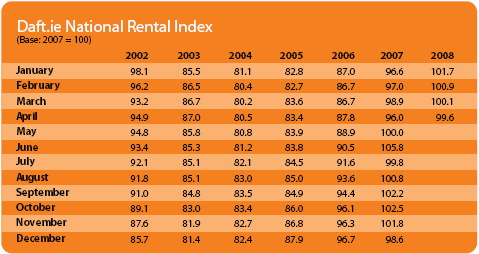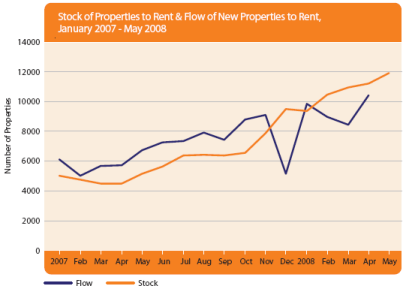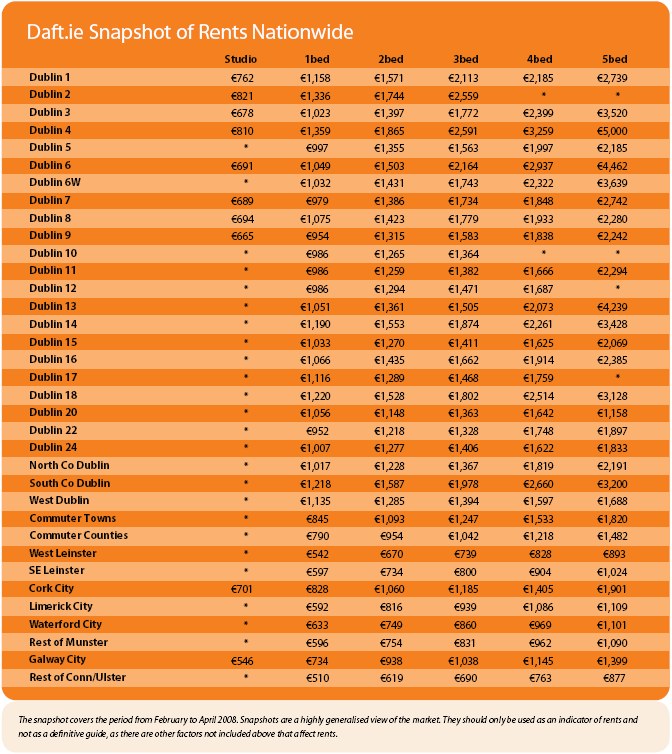Long-term investors not at risk from falling rents
Daft Reports
- Ronan Lyons (House Price, Q1 2024)
- Ronan Lyons (Rental Price, Q4 2023)
- Ronan Lyons (House Price, Q4 2023)
- Ronan Lyons (Rental Price, Q3 2023)
- Ronan Lyons (House Price, Q3 2023)
- Ronan Lyons (Rental Price, Q2 2023)
- Ronan Lyons (House Price, Q2 2023)
- Ronan Lyons (Rental Price, Q1 2023)
- Ronan Lyons (House Price, Q1 2023)
- Ronan Lyons (Rental Price, Q4 2022)
- Ronan Lyons (House Price, Q4 2022)
- Ronan Lyons (Rental Price, Q3 2022)
- Ronan Lyons (House Price, Q3 2022)
- Ronan Lyons (Rental Price, Q2 2022)
- Ronan Lyons (House Price, Q2 2022)
- Ronan Lyons (Rental Price, Q1 2022)
- Ronan Lyons (House Price, Q1 2022)
- Ronan Lyons (Rental, Q4 2021)
- Ronan Lyons (House Price, Q4 2021)
- Ronan Lyons (Rental, Q3 2021)
- Ronan Lyons (House Price, Q3 2021)
- Ronan Lyons (Rental, Q2 2021)
- Ronan Lyons (House Price, Q2 2021)
- Ronan Lyons (Rental, Q1 2021)
- Ronan Lyons (House Price, Q1 2021)
- Ronan Lyons (Rental, Q4 2020)
- Ronan Lyons (House Price, Q4 2020)
- Ronan Lyons (Wealth, H2 2020)
- Ronan Lyons (Rental, Q3 2020)
- Ronan Lyons (House Price, Q3 2020)
- Ronan Lyons (Housing, July 2020)
- Ronan Lyons (Housing, June 2020)
- Ronan Lyons (Housing, May 2020)
- Ronan Lyons (Rental, Q1 2020)
- Ronan Lyons (House Price, Q1 2020)
- Ronan Lyons (Rental, Q4 2019)
- Ronan Lyons (House Price, Q4 2019)
- Ronan Lyons (Wealth, H2 2019)
- Ronan Lyons (Rental, Q3 2019)
- Ronan Lyons (House Price, Q3 2019)
- Pierre Yimbog (Rental, Q2 2019)
- Ronan Lyons (House Price, Q2 2019)
- Ronan Lyons (Wealth, H1 2019)
- Ronan Lyons (Rental, Q1 2019)
- Ronan Lyons (House Price, Q1 2019)
- Ronan Lyons (Rental, Q4 2018)
- Ronan Lyons (House Price, Q4 2018)
- Ronan Lyons (Wealth, H2 2018)
- Ronan Lyons (Rental, Q3 2018)
- Ronan Lyons (House Price, Q3 2018)
- Shane De Rís (Rental, Q2 2018)
- Ronan Lyons (House Price, Q2 2018)
- Ronan Lyons (Wealth, 2018)
- Ronan Lyons (Rental, Q1 2018)
- Ronan Lyons (House Price, Q1 2018)
- Ronan Lyons (Rental, Q4 2017)
- Ronan Lyons (House Price, Q4 2017)
- Ronan Lyons (Rental, Q3 2017)
- Ronan Lyons (House Price, Q3 2017)
- Katie Ascough (Rental, Q2 2017)
- Ronan Lyons (Wealth, 2017)
- Ronan Lyons (House Price, Q2 2017)
- Ronan Lyons (Rental, Q1 2017)
- Ronan Lyons (House Price, Q1 2017)
- Ronan Lyons (Rental, Q4 2016)
- Ronan Lyons (House Price, Q4 2016)
- Ronan Lyons (Rental, Q3 2016)
- Ronan Lyons (House Price, Q3 2016)
- Ronan Lyons (School Report, 2016)
- Conor Viscardi (Rental, Q2 2016)
- Ronan Lyons (Rail Report, 2016)
- Ronan Lyons (House Price, Q2 2016)
- Ronan Lyons (Rental, Q1 2016)
- Ronan Lyons (House Price, Q1 2016)
- Ronan Lyons (Rental, Q4 2015)
- Ronan Lyons (House Price, Q4 2015)
- Ronan Lyons (Rental, Q3 2015)
- Ronan Lyons (House Price, Q3 2015)
- Marcus O'Halloran (Rental, Q2 2015)
- Ronan Lyons (House Price, Q2 2015)
- Ronan Lyons (Rental, Q1 2015)
- Ronan Lyons (House Price, Q1 2015)
- Ronan Lyons (Rental, Q4 2014)
- Ronan Lyons (House Price, Q4 2014)
- Ronan Lyons (Rental, Q3 2014)
- Ronan Lyons (House Price, Q3 2014)
- Domhnall McGlacken-Byrne (Rental, Q2 2014)
- Ronan Lyons (House Price, Q2 2014)
- Ronan Lyons (Rental, Q1 2014)
- Ronan Lyons (House Price, Q1 2014)
- Ronan Lyons (Rental, Q4 2013)
- Ronan Lyons (House Price, Q4 2013)
- Ronan Lyons (Rental, Q3 2013)
- Ronan Lyons (House Price, Q3 2013)
- Ronan Lyons (Rental, Q2 2013)
- Ronan Lyons (House Price, Q2 2013)
- Ronan Lyons (Rental, Q1 2013)
- Ronan Lyons (House Price, Q1 2013)
- Ronan Lyons (Rental, Q4 2012)
- Ronan Lyons (House Price, Q4 2012)
- Lorcan Sirr (Rental, Q3 2012)
- Padraic Kenna (House Price, Q3 2012)
- John Logue (Rental, Q2 2012)
- Ronan Lyons (House Price, Q2 2012)
- Barry O'Leary (Rental, Q1 2012)
- Seamus Coffey (House Price, Q1 2012)
- Joan Burton (Rental, Q4 2011)
- Ronan Lyons (House Price, Q4 2011)
- Philip O'Sullivan (Rental, Q3 2011)
- Sheila O'Flanagan (House Price, Q3 2011)
- Rachel Breslin (Rental, Q2 2011)
- Constantin Gurdgiev (House Price, Q2 2011)
- Cormac Lucey (Rental, Q1 2011)
- Eoin Fahy (House Price, Q1 2011)
- Lorcan Roche Kelly (Rental, Q4 2010)
- Ronan Lyons (House Price, Q4 2010)
- John Fitzgerald (Rental, Q3 2010)
- Patrick Koucheravy (House Price, Q3 2010)
- Gary Redmond (Rental, Q2 2010)
- Jim Power (House Price, Q2 2010)
- Jill Kerby (Rental, Q1 2010)
- Brian Lucey (House Price, Q1 2010)
- Michael Taft (Rental, Q4 2009)
- Alan McQuaid (House Price, Q4 2009)
- Dr. Charles J. Larkin (Rental, Q3 2009)
- Emer O'Siochru (House Price, Q3 2009)
- Ronan Lyons (Rental, Q2 2009)
- Oliver Gilvarry (House Price, Q2 2009)
- Brian Devine (Rental, Q1 2009)
- Dr. Liam Delaney (House Price, Q1 2009)
- Gerard O'Neill (Rental, Q4 2008)
- Ronan Lyons (House Price, Q4 2008)
- Dr. Stephen Kinsella (Rental, Q3 2008)
- Moore McDowell (House Price, Q3 2008)
- Shane Kelly (Rental, Q2 2008)
- Fergal O'Brien (House Price, Q2 2008)
- Eoin O'Sullivan (Rental, Q1 2008)
- Dermot O'Leary (House Price, Q1 2008)
- Dan O'Brien (Rental, Q4 2007)
- Frances Ruane (House Price, Q4 2007)
- John McCartney (Rental, Q3 2007)
- Ronnie O'Toole (House Price, Q3 2007)
- Ronan Lyons (Rental, Q2 2007)
- Constantin Gurdgiev (House Price, Q2 2007)
- Fintan McNamara (Rental, Q1 2007)
- Rossa White (House Price, Q1 2007)
- Geoff Tucker (Rental, Q4 2006)
- Damien Kiberd (House Price, Q4 2006)
- Pat McArdle (House Price, Q3 2006)
- Marc Coleman (House Price, Q2 2006)
- David Duffy (House Price, Q1 2006)
- Austin Hughes (House Price, Q4 2005)
- David McWilliams (House Price, Q2 2005)

20th May 2008
Dr. Eoin O'Sullivan is our guest blogger, analysing the Quarter 1 2008 figures.
The broad trend that emerges from the Daft Rental Report for the first quarter of 2008 is that rents dropped slightly between January and April. This follows a long period of rental growth, as after rents declined sharply between January 2002 and March 2004, they rose continuously, peaking in June 2007. The second half of 2007 was more volatile, but the emerging pattern is of a gradual decrease in rent levels. This is not all that surprising; indeed, it is only surprising that the decline is modest, given that the stock of properties available to rent nationwide increased from over 5,000 in May 2007 to almost 12,000 in May 2008.
Different regional trends persistAs ever, the national figure conceals notable regional differences, both in terms of rent levels and trends. While the trend is downwards in the majority of areas, West County Dublin and West Leinster are bucking the trend in recent months with rent increases evident. While rents in Dublin City Centre are down in recent months, the gap between the cost of renting a one-bedroom dwelling in the city centre versus West County Dublin remains considerable at approximately €400. Thus, it would appear that in many regions the supply of private rented property has met demand, and rent levels are beginning to reflect this new reality.
Attempting to explain the trends highlighted in the report is fraught with difficulty, but emerging evidence of a decline in employment in the construction sector, an easing in the flow of new migrants, sluggish sales on new houses leading in some cases to developers renting rather selling their properties, all are all possible contributors.
Long-term investors not at risk from falling rentsWhile recent trends will give some modest solace to first-time renters, should landlords be concerned about the possibility a gradual decline in rental yields? On balance, the answer is no, if their investment is long-term, the quality of their property is high and the property is professionally managed. Such properties will generate steady rents and an absence of voids, an issue that is becoming of increasing concern given the dramatic increase in the number of unlet properties in the market. Should tenants look forward to further rent declines? Yes, but they will be unevenly distributed geographically, and this may lead prospective and existing tenants to trade off location versus the cost of renting.
Landlords hold the key to the future of rental sectorA key issue is for the future health of the private rented sector is the motivation for becoming a landlord. Self-evidently, profit is the primary motivation, but whether renting property is viewed as a short-term or a long-term endeavour is crucial. It is of note that during the period when rents were declining, the stock of private rented dwellings increased in Ireland, suggesting that many landlords saw their investment as long-term, although many may have been attracted by the capital appreciation evident until recently.
Although the census figures are unreliable on the stock of private rented dwellings in Ireland, it is apparent from the mid-1990s that the historic decline of the sector in both absolute and relative terms was reversed. The most reliable current estimate is from the Private Rented Tenancies Board, which has over 200,000 registered tenancies, although as not all private rented accommodation has to be registered with the board, this underestimates the true extent of the sector. Whatever the increase, landlords who take a long term perspective on the yields they can derive from their properties, and crucially manage their properties in a professional manner, will achieve a satisfactory return.
Increasing regulation increases stability for all playersThe establishment of a new regulatory framework for the private rented sector since late 2004 (the Residential Tenancies Act, 2004) also contributes to an environment where landlords, tenants and third parties can resolve disputes in a costeffective and increasingly, in a timely fashion. The introduction of greater security of tenure for tenants under the Residential Tenancies Act, 2004 was greeted in some quarters with alarm, in the belief that landlords would flee the market when faced with tenants gaining security of tenure for three and a half years after an initial six month period (subject to certain conditions). The objective evidence is that rather than landlords fleeing the market, an increase in the number of properties for renting occurred; again suggesting that entry to the sector by the majority of investors was premised on a long term investment, rather than short-term gain.
The private rented sector currently serves the needs of a range of populations, from newly arriving migrants, to those in receipt of rent allowances, waiting to purchase or requiring flexible forms of accommodation to meet employment needs. The development of hybrid schemes, such as Rental Accommodation Scheme (RAS), suggests that the market for private renting is robust and, unlike the situation twenty years ago, is anything but the 'forgotten sector' of Irish housing in terms of both public and fiscal policy. The evidence from this Daft Rental Report is that the property market has cooled down, not only house prices but now also rents. Now that the boom period of ever-growing rents seems to have given way to a calmer period of more normal growth, this is the opportunity to take stock of the current situation of the rental sector. The challenge is to ensure the sector continues to professionalise in manner that meets the needs of all parties within balanced regulatory framework.
HIGHLIGHTS:

National Rental Index

Stock and Flow of Properties
SNAPSHOT:

Average Rents across Ireland in Q1 2008
